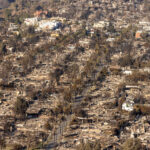The Federal Emergency Management Agency spent $35.1 million on renting two emergency generators to help power blacked-out San Juan, Puerto Rico. But a group of engineers says existing infrastructure could have been used more effectively at a fraction of the cost.
The mobile turbine generators, fully connected as of last week, bring some 50 megawatts to the partially idled Palo Seco plant west of the capital. That’s intended to stabilize power supply, at least in neighborhoods where distribution lines are intact.
Yet the Puerto Rico Professional College of Engineers and Land Surveyors said a better alternative was to turn on some of Palo Seco’s existing facilities to provide at least five times more power, according to a report delivered to local lawmakers and an interview with the organization’s president. Members of the group toured the plant Oct. 19 with a Senate delegation led by Larry Seilhamer, vice president of the body and an engineer by training.
About 70 percent of Puerto Ricans are still without electricity, including vast swaths of the capital of around 350,000 people. Pablo Vazquez Ruiz, president of the engineering college, said last week that the new generators will probably be insufficient for Puerto Rico’s most populous and economically important region.
“We’re in an emergency,” Vazquez Ruiz said. “We’re spending a lot of money with this, and we’re not supplying enough power to the metropolitan area.”
The generators were rented through a contract with Weston Solutions, a West Chester, Pennsylvania-based disaster response company. FEMA provided funding to the U.S. Army Corps of Engineers for such projects, and the Army Corps in turn assigned the contract to Weston.
Power Flashpoint
The provision of power six weeks after Hurricane Maria has become a flashpoint in a difficult and politically sensitive recovery.
The engineers’ findings come as federal lawmakers scrutinize a $300 million contract that Puerto Rico gave to Whitefish Energy Holdings LLC when it was a two-employee Montana-based company. In addition to the company’s tiny size, it has attracted attention because its previous known contracts were a fraction the size of the Puerto Rico deal, and it is based in the small hometown of Interior Secretary Ryan Zinke. Zinke and Whitefish have denied he played any role in the deal.
The uproar prompted the commonwealth to request the contract’s cancellation.
The concerns about Palo Seco reflect broader questions about FEMA money. In June, Inspector General John Roth warned of the agency’s “continued failure to manage disaster relief funds adequately,” in a letter to the chairman of the Senate Committee on Homeland Security and Governmental Affairs.
Like much of the infrastructure of the bankrupt Puerto Rico Electric Power Authority, or Prepa, the Palo Seco plant is in decay. In August, the utility announced it would shut down its four boiler-and-turbine units as long as six months for repairs by General Electric Co., and rely on power from other plants for San Juan.
Corrosion in structural framing posed “a current imminent threat to the safety of personnel,” according to a report by West Islip, New York-based Island Structures Engineering PC, a sub-consultant. Pictures in the report showed rust and other degradation to the structures, which were built in the 1950s and 1960s and sit just yards from the Bay of San Juan.
Mothballed Equipment
But Puerto Rican engineers now say the crisis should prompt the government to revisit its decision. If nothing else, the government should demand that GE – which is charging about $5 million – provide an accelerated timetable that focuses on the most essential tasks, Vazquez Ruiz said.
He said one boiler could be running safely in less than two weeks, and two could be going in three weeks. Another apparently usable boiler was disabled to connect the rental generators, Vazquez Ruiz said.
“Why would you spend that taxpayer money when you could fix this” with the money already paid to GE, said Vazquez Ruiz, a former Army Corps deputy district engineer whose responsibility included oversight of Puerto Rico.
Ramon Rosario, Puerto Rico’s public affairs secretary, told reporters last week that the government would consider the engineers’ findings. But in an emailed statement Tuesday, Rosario said the government considered the Island study “conclusive,” based on a more thorough inspection by a company that had been monitoring the plant for years.
By comparison, he said, the College of Engineers report was based on a visual assessment over a few hours. He also said the engineers didn’t evaluate the plant when the machinery was turned on, referencing a disclosure in the report itself. “They did not do other necessary tests,” he said.
Katie Jackson, a GE spokeswoman, said in a prepared statement that the company’s “scope of work at the Palo Seco power plant is limited to repairing the boiler structure.” She didn’t address the question of whether the job could be accelerated, but said the company anticipates “exploring other opportunities to help.”
Jeffrey Hawk, a spokesman for the Corps of Engineers in Puerto Rico, said the generators were rented to execute a mission assigned by FEMA, which is funding much of Puerto Rico’s recovery efforts. FEMA referred questions on the matter to the Corps of Engineers. Prepa didn’t respond to a request for comment.
San Juan Mayor Carmen Yulin Cruz said the engineers’ study should be taken seriously.
“I respect the College of Engineers,” she said. “They have no political agenda. They are licensed engineers, so they wouldn’t be saying something should work if something does not work, because their reputations are at stake.”
Meanwhile, the idled plant has angered residents eager to return to normalcy. On a recent day, graffiti on a cement wall outside the plant read: “Turn it back on!”
Was this article valuable?
Here are more articles you may enjoy.

 Teen’s Suicide Turns Mother Against Google, AI Chatbot Startup
Teen’s Suicide Turns Mother Against Google, AI Chatbot Startup  Catastrophe Experts Tap AI to Tackle Soaring Insured Losses
Catastrophe Experts Tap AI to Tackle Soaring Insured Losses  Deutsche Bank, Mudrick Sue Ambac Over $65 Million Transfer
Deutsche Bank, Mudrick Sue Ambac Over $65 Million Transfer  Trump’s Tariffs Threaten to Endanger the Cheap American Car
Trump’s Tariffs Threaten to Endanger the Cheap American Car 